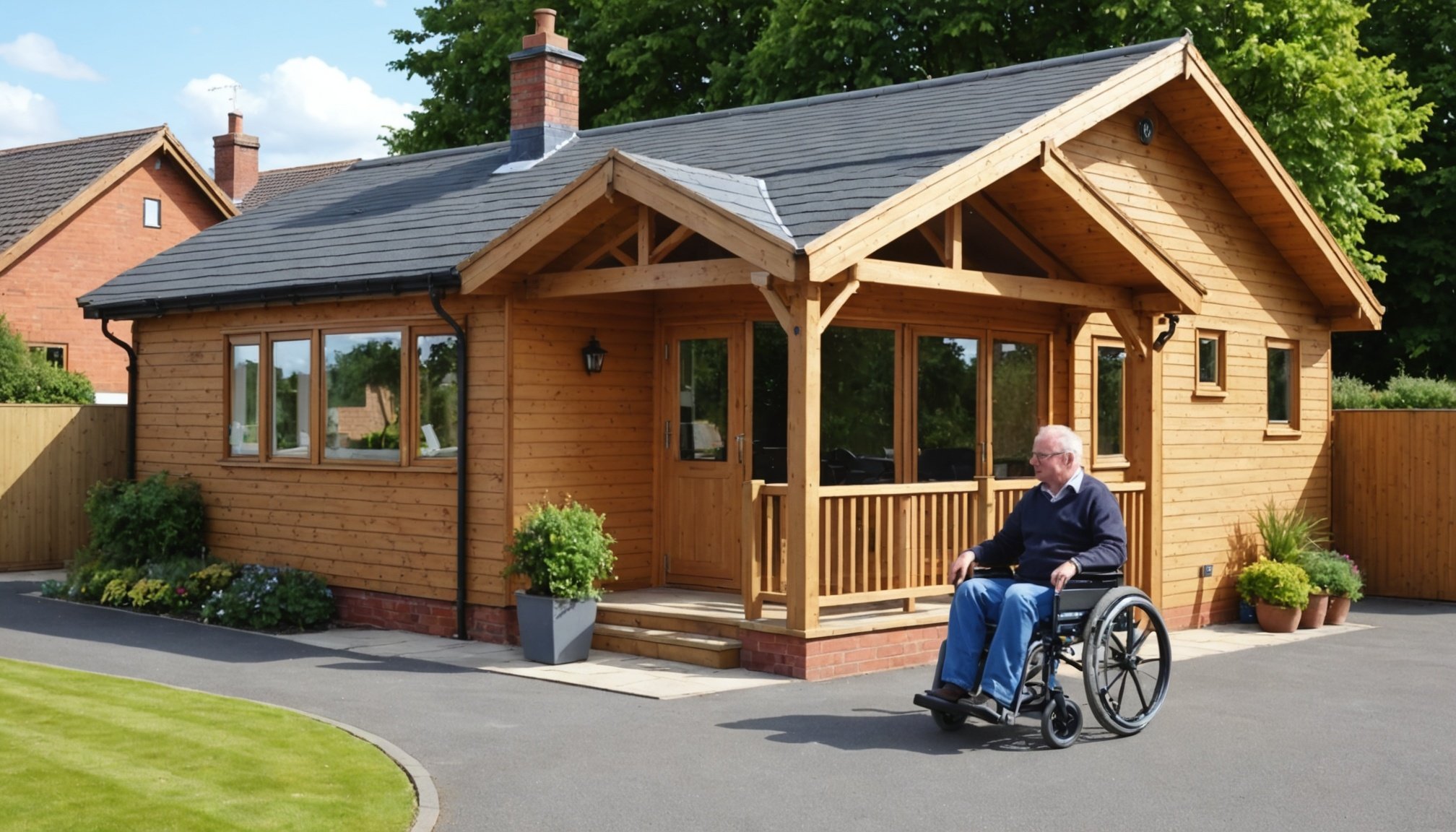Transforming UK Bungalows for Perfect Wheelchair Access: The Ultimate Handbook
Understanding the Needs of Wheelchair Users
When it comes to creating a home that is accessible and comfortable for everyone, especially those with mobility needs, it’s crucial to understand the specific requirements of wheelchair users. This involves more than just installing ramps or widening doorways; it requires a holistic approach to building and converting homes.
For instance, in Devon, there are several initiatives and accommodations designed to be inclusive for people with disabilities. These include specially designed farm cottages that cater to families with additional needs, such as autism, and offer features like quiet rooms and staff trained in disability and dementia care[1].
In the same genre : Key factors to choose the ideal shed for your uk garden oasis
Assessing Your Property
Before you begin any transformation, it’s essential to assess your property to determine what changes are necessary and feasible. Here are some key areas to consider:
Ground Floor Living
- Single Storey Living: Bungalows are ideal for wheelchair access because they are single-storey, eliminating the need for stairs. However, if you’re considering a loft conversion, ensure that the design includes a lift or other accessible features.
- Open Plan Spaces: Open plan living areas can be highly beneficial as they provide unobstructed space for easy navigation.
Entrance and Doorways
- Wide Doorways: Ensure all doorways are at least 80cm wide to accommodate wheelchairs comfortably.
- Ramps and Thresholds: Install ramps with gentle slopes and remove or lower thresholds to facilitate smooth entry.
Bathroom Adaptations
- Accessible Bathrooms: Install walk-in showers, grab bars, and non-slip flooring. Consider a wet room design for easier access.
- Height-Adjustable Fixtures: Use height-adjustable sinks and toilets to cater to different needs.
Bedroom Modifications
- Bedroom Space: Ensure the bedroom is spacious enough to accommodate a wheelchair and has easy access to storage and other facilities.
- Emergency Alarms: Install emergency alarms and intercom systems for added safety.
Planning and Permissions
Transforming your bungalow into a wheelchair-accessible home often requires careful planning and adherence to local regulations.
Topic to read : Shop the best jewelry box options for every style and need
Planning Permission
- Permitted Development: Check if your planned changes fall under permitted development rights, which allow certain types of work without needing full planning permission.
- Local Council Approval: If your project requires planning permission, ensure you submit detailed plans and consult with your local council to avoid any delays or rejections.
Building Regulations
- Accessibility Standards: Ensure your modifications meet the building regulations and accessibility standards set by the government. This includes compliance with the World Wide Web Consortium (W3C) Web Accessibility Initiative double AA standards for any digital components, though this is more relevant to public buildings and websites[4].
Building and Conversion Tips
Here are some practical tips for building or converting your bungalow:
Self Build Options
- Oak Frame Construction: Consider using oak frame construction for its durability and adaptability. Oak frames can be designed to include wide doorways and open plan spaces.
- Custom Designs: Work with architects who specialize in accessible housing to create a custom design that meets your specific needs.
Loft Conversions
- Lift Installation: If you decide to include a loft conversion, installing a lift is crucial for maintaining accessibility.
- Accessible Roof Space: Ensure the loft space is designed with accessibility in mind, including wide staircases or lifts, and adequate lighting.
Support and Resources
Transforming a bungalow into a wheelchair-accessible home can be a complex process, but there are many resources available to support you.
Local Support
- Social Care Services: Consult with local social care services to understand the specific needs of the individuals who will be using the property.
- Disability Organizations: Organizations like Simply Emma, which focuses on accessible travel and living, can provide valuable insights and tips for creating an accessible home[3].
Government Initiatives
- Government Grants: Explore government grants and funding options available for making homes more accessible.
- Building Regulations Guidance: The government provides detailed guidance on building regulations and accessibility standards, which can be invaluable during the planning phase.
Practical Insights and Actionable Advice
Here are some practical insights and actionable advice to help you in your journey:
Mental Health Considerations
- Mental Health Benefits: Creating an accessible home can have significant mental health benefits for the occupants. For example, autistic people often benefit from predictable and safe environments, which can be achieved through thoughtful design[1].
Learning Disability Support
- Customized Spaces: For people with learning disabilities, customized spaces that are easy to navigate and free from clutter can be highly beneficial.
- Sensory Considerations: Consider the sensory needs of the occupants when designing the space. This might include using calming colors, reducing noise levels, and incorporating natural light.
Detailed Checklist for Wheelchair Accessible Bungalows
Here is a detailed checklist to ensure your bungalow is fully accessible:
-
Entrance
-
Wide doorways (at least 80cm)
-
Ramps with gentle slopes
-
Low or no thresholds
-
Automatic doors or easy-to-use door handles
-
Interior Spaces
-
Open plan living areas
-
Wide corridors (at least 90cm)
-
Level access to all rooms
-
Emergency alarms and intercom systems
-
Bathroom
-
Walk-in shower or wet room
-
Grab bars and non-slip flooring
-
Height-adjustable fixtures
-
Emergency alarm system
-
Bedroom
-
Spacious room with easy access to storage
-
Adjustable bed and furniture
-
Natural light and ventilation
-
Outdoor Spaces
-
Accessible garden paths
-
Level access to outdoor areas
-
Secure and easy-to-use outdoor furniture
Comparative Table: Accessibility Features in Different Types of Homes
| Feature | Bungalow | Two-Storey House | Loft Conversion |
|---|---|---|---|
| Ground Floor Living | Ideal for wheelchair users | Limited ground floor space | Requires lift installation |
| Doorway Width | Easy to widen doorways | May require significant modifications | Depends on design |
| Bathroom Adaptations | Easy to install walk-in showers | May require more complex adaptations | Can be challenging without lift |
| Bedroom Modifications | Spacious bedrooms possible | Limited space on ground floor | Requires careful planning |
| Outdoor Access | Easy to create accessible garden paths | May require ramps or lifts | Depends on design and lift installation |
Quotes and Testimonials
-
“Creating an accessible home is not just about physical changes; it’s about creating a space that supports the mental and emotional well-being of its occupants.” – Emma, Simply Emma[3].
-
“The key to a successful accessible home is in the details. From wide doorways to height-adjustable fixtures, every aspect must be considered to ensure comfort and independence.” – Local Architect.
Transforming a UK bungalow into a wheelchair-accessible home is a rewarding and necessary endeavor that requires careful planning, adherence to regulations, and a deep understanding of the needs of the occupants. By following the guidelines and tips outlined in this handbook, you can create a home that is not only accessible but also supportive of the mental and physical health of its residents.
Remember, accessibility is not just about building regulations; it’s about building a home that feels like home for everyone. Whether you’re self-building, converting a loft, or simply adapting your existing space, the end goal is to create a place where people can live comfortably and independently.



